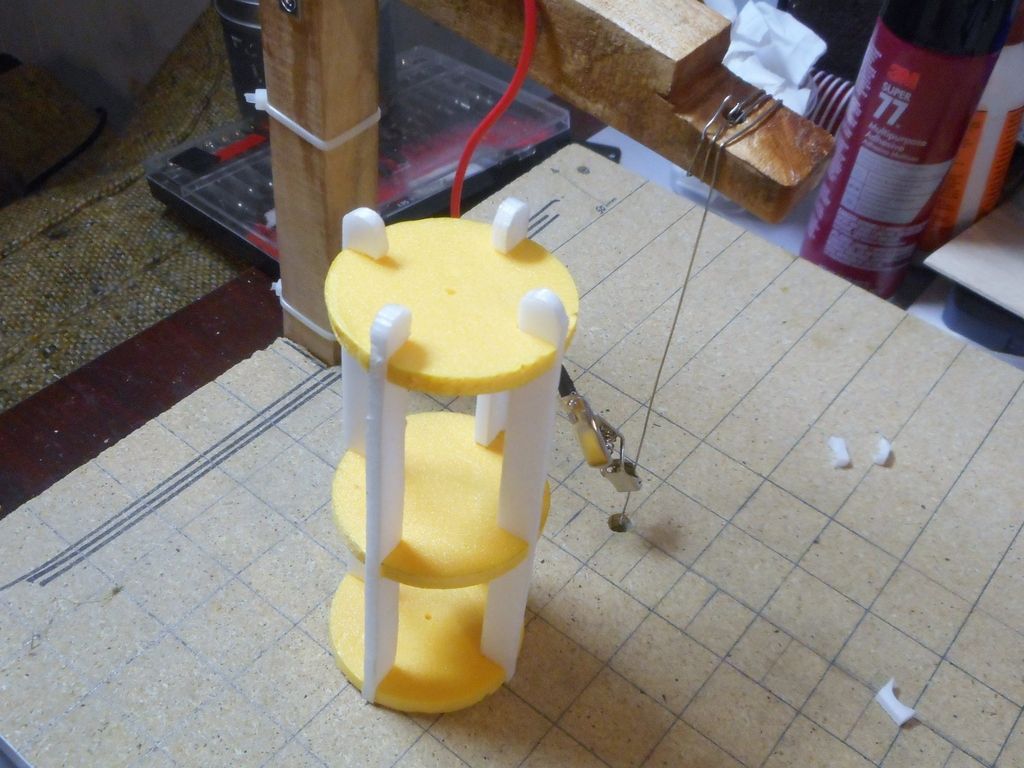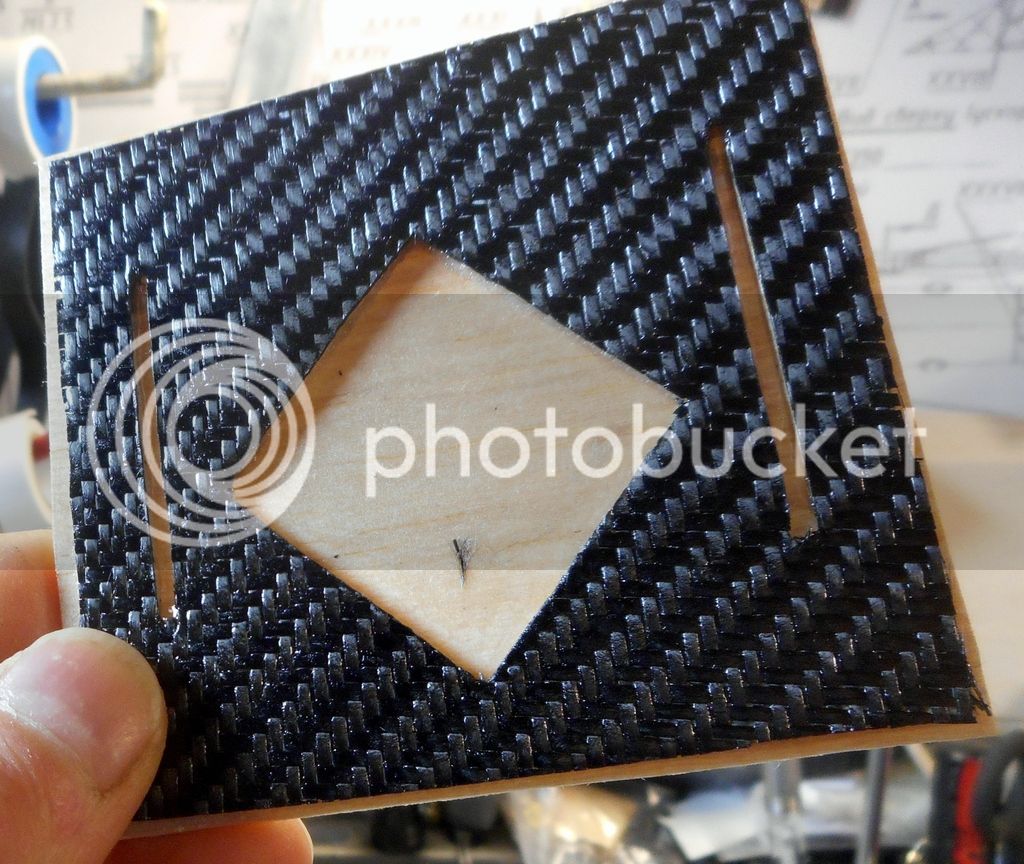TopRamen
SA-5
- Joined
- Aug 9, 2013
- Messages
- 9,955
- Reaction score
- 111
After the clear coat got cooked on my first CF Star Trooper, and the repairs were just plain UGLY, I decided to simply make another body tube, and incorporate the lessons learned into the new one. It took a firm pull, but I was able to pop the fins and the rail guide off the first one without damaging them, so in this thread, I will show how I made both when we get to that part, but we will basically start from scratch, beginning with the body tube.
Before we begin, a quick primer to get anyone just joining my carbon fiber adventure up to speed with the what and why.
I enjoy the Star Trooper design, and it makes a good platform for experimenting with new techniques and materials. That's the what. The why, well that's simple. To simply enjoy building a rocket, regardless of what it needs to be, and to instead make it what I want it to be, and have a ton of fun along the way.
The first go around was my very first foray into making a tube from a cloth, around a mandrel, and in my effort to make it as light as possible, I only did about one layer with about a 3/8" overlapping seam.
This would have been fine strength wise, but the heat of the ejection charge on it's maiden flight caused the epoxy and clear-coat to boil into a mess. Most carbon fiber tubes use multiple layers for strength and are best suited to high power applications. They end up thick enough that the ejection charge does not present a threat to the integrity of the airframe, and in many cases use electronics to handle an ejection charge that is not even part of the motor assembly.
For my purposes, I simply want to learn about the properties of CF, and how to use it, regardless of it being necessary or not.
Anyhow, this thread will show how I SHOULD have done it, seeing as how I don't like only getting one flight out of such a fun little rocket.
I decided to try something I've never done before, peeling off the glassine layer on a body tube.
Much to my surprise, the tube went from weighing 3g. on my scale to weighing 0g.:shock::y:
Who knew that most of the weight of a BT is that glassine layer? A lot of folks apparently, as this is common practice in glassing, yet I never had the nerve to try it til now.:confused2:

Now I have something to wrap my CF onto, that will guaranty the internal dimensions are correct, and it adds little weight. It will also insulate my CF wrapping from the heat of the ejection gasses.
When it it wrapped and cured, I'll seal the inside with CA like I do on all paper tubes to prevent the build up of crud that draws moisture into the tube.
I got my stripped BT onto the mandrel, and next it will be time to cut cloth and apply it using BSI brand 20 minute epoxy, which I experimented with today on the CF for the first time and had appreciable results as far as how rapidly it absorbed into the CF. Previously, I had been using the 15 minute stuff, and it is simply not wet enough to fully absorb into the CF.

As stated earlier, even though I already have some of the parts made, we'll just either make them again, or I'll share the pictures of the making process, as I document everything in pictures even if I am not doing a build thread.
I think that some of you will appreciate the methods I have used to make components that otherwise would require tools like a bandsaw and such.
I have a lot of other builds going on right now, and as such was not going to do one for this, but enough folks here liked the rocket that I will gladly share what I did to make it, especially now that I can make it better than I did the first time.
The Carbon Fiber was given to me by a member here, and I feel it only proper to share the enjoyment of working with it with everyone. It is a downright enjoyable material, both texture wise and equally so visually.
Before we begin, a quick primer to get anyone just joining my carbon fiber adventure up to speed with the what and why.
I enjoy the Star Trooper design, and it makes a good platform for experimenting with new techniques and materials. That's the what. The why, well that's simple. To simply enjoy building a rocket, regardless of what it needs to be, and to instead make it what I want it to be, and have a ton of fun along the way.
The first go around was my very first foray into making a tube from a cloth, around a mandrel, and in my effort to make it as light as possible, I only did about one layer with about a 3/8" overlapping seam.
This would have been fine strength wise, but the heat of the ejection charge on it's maiden flight caused the epoxy and clear-coat to boil into a mess. Most carbon fiber tubes use multiple layers for strength and are best suited to high power applications. They end up thick enough that the ejection charge does not present a threat to the integrity of the airframe, and in many cases use electronics to handle an ejection charge that is not even part of the motor assembly.
For my purposes, I simply want to learn about the properties of CF, and how to use it, regardless of it being necessary or not.
Anyhow, this thread will show how I SHOULD have done it, seeing as how I don't like only getting one flight out of such a fun little rocket.
I decided to try something I've never done before, peeling off the glassine layer on a body tube.
Much to my surprise, the tube went from weighing 3g. on my scale to weighing 0g.:shock::y:
Who knew that most of the weight of a BT is that glassine layer? A lot of folks apparently, as this is common practice in glassing, yet I never had the nerve to try it til now.:confused2:

Now I have something to wrap my CF onto, that will guaranty the internal dimensions are correct, and it adds little weight. It will also insulate my CF wrapping from the heat of the ejection gasses.
When it it wrapped and cured, I'll seal the inside with CA like I do on all paper tubes to prevent the build up of crud that draws moisture into the tube.
I got my stripped BT onto the mandrel, and next it will be time to cut cloth and apply it using BSI brand 20 minute epoxy, which I experimented with today on the CF for the first time and had appreciable results as far as how rapidly it absorbed into the CF. Previously, I had been using the 15 minute stuff, and it is simply not wet enough to fully absorb into the CF.

As stated earlier, even though I already have some of the parts made, we'll just either make them again, or I'll share the pictures of the making process, as I document everything in pictures even if I am not doing a build thread.
I think that some of you will appreciate the methods I have used to make components that otherwise would require tools like a bandsaw and such.
I have a lot of other builds going on right now, and as such was not going to do one for this, but enough folks here liked the rocket that I will gladly share what I did to make it, especially now that I can make it better than I did the first time.
The Carbon Fiber was given to me by a member here, and I feel it only proper to share the enjoyment of working with it with everyone. It is a downright enjoyable material, both texture wise and equally so visually.





































